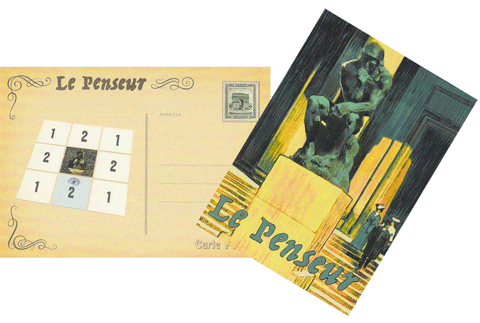
Paris is a very enjoyable, good fun, lightwieght two-player board game, created by José Antonio Abascal in 2019.
It’s made all the more delightful by the ‘postcards’ by artist Oriol Hernández, which capture Paris of old, and are a central component of the game.
The two-player tussle is set Paris during the 1889 “Exposition Universelle,” or World Fair, at a time when publicly available electricity was new to the world, and a very hot topic. Electric lighting spread through the city, creating today’s beautiful nocturnal Parisian streets and leading Paris to be given the nickname “La Cité de la Lumière”; the city of light.
The streets and well-lit buildings of Paris are still much admired by amblers and passers-by after nightfall.
Paris is played in two separate and quite different phases.
In both, there’s a continuous demand to be alert to the way that the cobblestoned streets of Paris are being laid out – the patterns and shapes matter. It’s quite a ‘visual’ game, then.
Phase one

During the first phase, players can either place cobblestone tiles, or they can expand their
‘in hand’ reserve of buildings … which also are contained on tiles.
The buildings are there for all to view, and come in various shapes and sizes.
Oh! Remember !
Building tiles that have not been placed at the end of the game bring about penalty points !
Both players have eight cobblestone tiles, each of which is divided into four square segments. These four squares differ from tile to tile, and they may include the player’s own coloured cobbles (either blue or orange), their opponents’ cobbles, a streetlight,
or a mixed-colour, purple square [a kind of wild-cobble 😁].
Upon that, either player will later be able to build.
The goal is to lay out your cobblestones so that you’ll later be able to place buildings upon them and thus gain points.
You draw the tiles at random, so it’s a case of doing the best you can,
with no guarantee about what tiles will come next,
nor how they will be placed.
Another problem is that the buildings are of different shapes & sizes, so visualising how you might eventually fit them onto your own coloured cobblestones
or ‘wild-cobbles’ calls for quite a bit of chin stroking.

Phase two
In the second phase, the ability to visualise where best to place one’s buildings matters.
Players can choose either to place their buildings on top of their own-coloured cobblestones and the ‘wildcard’ spaces, or to choose a postcard.
A core goal is to position one’s buildings as close to as many streetlights as possible, because more streetlights means more light, and that means that buildings can be seen and admired the more readily ~ and that leads to more points.

But instead of building, players can take possession of one of the eight postcards that are available ~ they bring extra options and advantages.
Rodin’s Le Penseur, for example, brings the chance of gaining quite a few extra points if the front of the statue can remain accessible
to the admiring crowds until the end of the game.
But if anybody or anything blocks the front-view, then nothing’s gained.
The player with the biggest and best lit buildings may end up
stealing the hearts of the evening strollers,
and winning the game,
especially if they also have managed to grab the le Peintre (painter), the Moulin Rouge dancer,
or le Penseur statue.


